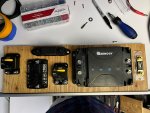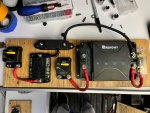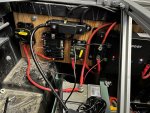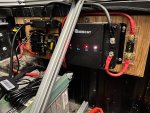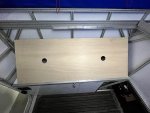You are using an out of date browser. It may not display this or other websites correctly.
You should upgrade or use an alternative browser.
You should upgrade or use an alternative browser.
I decided to build my own Pop Top camper
- Thread starter 97heavyweight
- Start date
97heavyweight
Well-known member
I'm not using Foam. I'm using 3M insulation. It's thicker and when compressed provides a higher R value than the pink foam board. That is a good idea about the metal I hadn't thought of that, but it is what is causing me issues now. I was thinking of going the expanded PVC board route. I just want to make sure that a 3mm PVC board will have enough rigidity.I would avoid a metal skin on the inside at all costs if you do winter camping. That will guarantee condensation. Have you thought about gluing the FRP to foam?
I used 1/2” PVC board on my interior and it requires some support to not flex, my largest span is about 18” and you can stand on it, but it moves. If you’re trying to use 1/8” PVC or FRP to keep soft insulation compressed in small spaces, it come out looking like the Michelin Man. This wouldn’t be the case with foam board, it would add rigidity to a thin plastic panel.
rruff
Explorer
I was thinking of going the expanded PVC board route. I just want to make sure that a 3mm PVC board will have enough rigidity.
It's not rigid. If you use thicker expanded PVC and put rigid skins on it, it wouldn't be bad.
You'll find that all these non-wood boards have less stiffness per weight and way more cost than wood. Wood is a very good material for interior stuff. Why are you wanting to avoid it?
You might check CarbonCore's availability on their panels that have fiberglass skins and plastic hex core. They'd be strong/rigid/light and the price wasn't too bad last I checked.
97heavyweight
Well-known member
I'm wanting to stay away from wood for two reasons. Weight and I live in the PNW so moisture is always an issue. I'll look into carboncore.It's not rigid. If you use thicker expanded PVC and put rigid skins on it, it wouldn't be bad.
You'll find that all these non-wood boards have less stiffness per weight and way more cost than wood. Wood is a very good material for interior stuff. Why are you wanting to avoid it?
You might check CarbonCore's availability on their panels that have fiberglass skins and plastic hex core. They'd be strong/rigid/light and the price wasn't too bad last I checked.
97heavyweight
Well-known member
That is good to know about the 1/2". My biggest issue is there is no real support on the edges because of how my frame is made.I used 1/2” PVC board on my interior and it requires some support to not flex, my largest span is about 18” and you can stand on it, but it moves. If you’re trying to use 1/8” PVC or FRP to keep soft insulation compressed in small spaces, it come out looking like the Michelin Man. This wouldn’t be the case with foam board, it would add rigidity to a thin plastic panel.
rruff
Explorer
This is the CarbonCore panel page. https://www.carbon-core.com/product/composite-panels-sheets/
When I ordered foam from them shipping usually worked out to ~$300 no matter the amount... freight for large pieces.
I still think wood is a good way to go for interiors. It isn't heavy... rather light compared to alternatives. If you want to make it really light you can use thin ply as skins with a foam core. Moisture shouldn't be a problem for interiors.
When I ordered foam from them shipping usually worked out to ~$300 no matter the amount... freight for large pieces.
I still think wood is a good way to go for interiors. It isn't heavy... rather light compared to alternatives. If you want to make it really light you can use thin ply as skins with a foam core. Moisture shouldn't be a problem for interiors.
97heavyweight
Well-known member
I was poking around on their site earlier. I might try wood and see what happens. I'll probably screw it in place so if I do have issues it will be easy enough to look and fix later. I do see lots of builds using wood so I guess I can too.This is the CarbonCore panel page. https://www.carbon-core.com/product/composite-panels-sheets/
When I ordered foam from them shipping usually worked out to ~$300 no matter the amount... freight for large pieces.
I still think wood is a good way to go for interiors. It isn't heavy... rather light compared to alternatives. If you want to make it really light you can use thin ply as skins with a foam core. Moisture shouldn't be a problem for interiors.
CoyoteThistle
Adventurer
I just went through this process as I'm adding insulation panels to composite walls and need new inner walls to cover it. After trying to make FRP work, I went with 1/8" luan plywood. Very light weight stuff. painted or properly sealed plywood is pretty darn moisture resistant.
ITTOG
Well-known member
Definitely seal the wood and you will reduce moisture issues. One thing to consider if sealed Luan doesn't world is to put a couple layers of glass on it. It will greatly strengthen it, no Michellen man, and prevent moisture issues with the wood.I was poking around on their site earlier. I might try wood and see what happens. I'll probably screw it in place so if I do have issues it will be easy enough to look and fix later. I do see lots of builds using wood so I guess I can too.
Sent from my Pixel 6 Pro using Tapatalk
97heavyweight
Well-known member
Do you have pictures of what it looks like?I just went through this process as I'm adding insulation panels to composite walls and need new inner walls to cover it. After trying to make FRP work, I went with 1/8" luan plywood. Very light weight stuff. painted or properly sealed plywood is pretty darn moisture resistant.
97heavyweight
Well-known member
Alright today is the day. I am waiting on one Kill Switch and the bus bar to complete my new electrical setup. I attached a sketch of what i'm going to be doing. Someone who has some experience please tell me if I am missing anything. I know it'll work, but perhaps it could be better. Hopefully my sketch makes sense.
Attachments
CoyoteThistle
Adventurer
It's a work in progress, not installed yet. Hopefully in the next week I will though.Do you have pictures of what it looks like?
97heavyweight
Well-known member
Last night I got the new electrical system in and tested. It is charging the house battery with the alternator. Once I have the ceiling done I will take it out of the garage and test the solar portion. I still have to install the battery temp and voltage sensors and put an inline fuse in the solar line.
Attachments
97heavyweight
Well-known member
I've got the new wiring all sorted out and everything is working great. This past weekend my goal was to get the roof insulated and that was an epic failure. I decided to go with 1/4" Luan Plywood and when I went to rip the boards to their final dimensions I did some awful math and shorted the front and rear piece both by an inch. With the width of my camper being 60" that means I just wasted two sheets of Luan ply. ugh. So I went home to re-evaluate and on Monday bought two more sheets then I decided to take a break on the camper and go use it. It has been so long since I have driven my truck that I forgot I had steering wheel controls for the radio.
Attachments
Similar threads
- Replies
- 4
- Views
- 1K
- Replies
- 0
- Views
- 687


